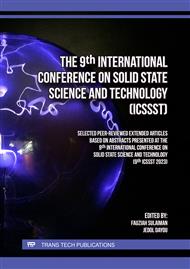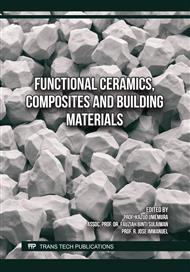[1]
M. Anis-Ur-Rehman and M. Mubeen, "Synthesis and enhancement of current density in Cerium doped Bi(Pb)Sr(Ba)-2223 high TC superconductor," Synth. Met., vol. 162, no. 19–20, p.1769–1774, 2012.
DOI: 10.1016/j.synthmet.2012.03.006
Google Scholar
[2]
F. Ben Azzouz, A. M'Chirgui, B. Yangui, C. Boulesteix, and M. Ben Salem, "Synthesis, microstructural evolution and the role of substantial addition of PbO during the final processing of (Bi,Pb)-2223 superconductors," Phys. C Supercond. its Appl., vol. 356, no. 1–2, p.83–96, 2001.
DOI: 10.1016/s0921-4534(01)00124-1
Google Scholar
[3]
S. Ebrahim, M. Ghahfarokhi, and F. Joola, "AC magnetic susceptibility of Cd-doped the sol-gel method," Chinese J. Phys., vol. 54, p.921–930, 2016.
DOI: 10.1016/j.cjph.2016.09.005
Google Scholar
[4]
H. Azhan, K. Azman, and S. Y. S. Yusainee, "The role of antimony (Sb) addition on BSCCO superconductor," Solid State Sci. Technol., vol. 17, no. 1, p.215–221, 2009.
Google Scholar
[5]
R. R. Kothawale, B. N. Dole, and S. S. Shah, "Effect of substitution of Ce on superconducting properties of Bi1.7Pb0.3Sr2Ca2−xCexCu3O10+ δ system," Pramana-Journal Phys., vol. 58, no. 2212, p.871–875, 2002.
DOI: 10.1007/s12043-002-0185-2
Google Scholar
[6]
O. Bilgili, "Structural and Electrical Properties of Nanosized Sm2O3 Doped Bi1.6Pb0.4Sr2Ca2Cu3Oy Superconductors," J. Low Temp. Phys., vol. 204, p.223–234, 2021.
DOI: 10.1007/s10909-021-02607-6
Google Scholar
[7]
A. Harabor, P. Rotaru, and N. A. Harabor, "Effect of Ni substitute in off-stoichiometric Bi(Pb)-Sr-Ca-Cu(Ni)-O superconductor. Excess conductivity, XRD analysis and thermal behaviour," Ceram. Int., vol. 45, no. 2, p.2742–2750, 2019.
DOI: 10.1016/j.ceramint.2018.09.060
Google Scholar
[8]
P. M. Sarun, S. Vinu, R. Shabna, A. Biju, and U. Syamaprasad, "Properties of superconducting, polycrystalline dysprosium-doped Bi1.6Pb0.5Sr2-xDyxCa1.1Cu2.1O8+δ (0 ≤ x ≤ 0.5)," Mater. Res. Bull., vol. 44, no. 5, p.1017–1021, 2009.
DOI: 10.1016/j.materresbull.2008.11.013
Google Scholar
[9]
Ö. Bilgili and M. Yurddaskal, "Effects of Graphene Oxide doping on magnetic and structural properties of Bi1.6Pb0.4Sr2Ca2Cu3Oy superconductor," J. Electron. Mater., vol. 50, no. 8, p.4999–5006, 2021.
DOI: 10.1007/s11664-021-09023-2
Google Scholar
[10]
S. J. Hao, W. T. Jin, X. J. Zhang, Y. Zhao, and H. Zhang, "Relation of structure and superconductivity in self-compensated Y1-xCaxBa2Cu3-xAlxOz system," J. Supercond. Nov. Magn., vol. 23, no. 5, p.819–822, 2010.
DOI: 10.1007/s10948-010-0713-0
Google Scholar
[11]
H. Azhan, J. S. Hawa, C. M. N. Azura, K. Azman and S. A. Syamsyir, "Structural and electrical properties of high and low density Yb-doped Bi(Pb)-2223 superconductor" Jurnal Teknologi, vol. 78, pp.7-12, 2016.
DOI: 10.11113/jt.v78.9014
Google Scholar
[12]
M. Anas, "The effect of PbF2 doping on the structural, electrical and mechanical properties of (Bi,Pb)–2223 superconductor," Chem. Phys. Lett., vol. 742, no. December 2019, 2020.
DOI: 10.1016/j.cplett.2019.137033
Google Scholar
[13]
M. S. Lee and K. Y. Song, "Effect of Nd substitution for the Ca site in the 110 K phase of (Bi,Pb)-Sr-Ca-Cu-O superconductors," Supercond. Sci. Technol., vol. 15, no. 6, p.851–854, 2002.
DOI: 10.1088/0953-2048/15/6/301
Google Scholar
[14]
J. S. Hawa, H. Azhan, S. Y. Yahya, K. Azman, H. N. Hidayah, and A. W. Norazidah, "The effect of Eu substitution onto Ca site in Bi(Pb)-2223 superconductor via co-precipitation method," J. Supercond. Nov. Magn., vol. 26, no. 4, p.979–983, 2013.
DOI: 10.1007/s10948-012-2043-x
Google Scholar
[15]
O. Ozturk, M. Akdogan, H. Aydin, M. Yilmazlar, C. Terzioglu, and I. Belenli, "Substitution of Sm at Ca site in Bi1.6 Pb0.4Sr2Ca2-xSmxCu3Oy superconductors," Phys. B Condens. Matter, vol. 399, no. 2, p.94–100, 2007.
DOI: 10.1016/j.physb.2007.05.028
Google Scholar
[16]
C. Terzioglu, M. Yilmazlar, O. Ozturk, and E. Yanmaz, "Structural and physical properties of Sm-doped Bi1.6Pb0.4Sr2Ca2-xSmxCu3Oy superconductors," Phys. C Supercond. its Appl., vol. 423, no. 3–4, p.119–126, 2005.
DOI: 10.1016/j.physc.2005.04.008
Google Scholar
[17]
H. Y. Wu et al., "Effect of K and Nd substitutions on superconductivity of Bi2223 superconductors," Supercond. Sci. Technol., vol. 20, no. 12, p.1189–1192, 2007.
DOI: 10.1088/0953-2048/20/12/019
Google Scholar
[18]
I. N. Syuhaida, H. Azhan, K. Azman, C. M. N. Azura, and M. Robaiah, "Synthesis and characterization of low density Bi-2223 superconductors via co-precipitation method," Adv. Mater. Res., vol. 1107, p.611–615, 2015.
DOI: 10.4028/www.scientific.net/amr.1107.611
Google Scholar
[19]
A. I. Abou-Aly, M. M. H. Abdel Gawad, R. Awad, and I. G-Eldeen, "Improving the physical properties of (Bi, Pb)-2223 Phase by SnO2 Nano-particles addition," J. Supercond. Nov. Magn., vol. 24, no. 7, p.2077–2084, 2011.
DOI: 10.1007/s10948-011-1171-z
Google Scholar
[20]
E. Brecht, W.W. Schmah, G. Miehe, M. Rodewald, H. Fuess, N.H. Andersen, J. Hanβmann, Th. Wolf, "Thermal treatment of YBa2Cu3-xAlxO6+δ single crystals in different atmospheres and neutron-diffraction study of excess oxygen pinned by the Al substituents," Phys. C Supercond. its Appl., vol. 265, no. 1–2, p.53–66, 1996.
DOI: 10.1016/0921-4534(96)00255-9
Google Scholar
[21]
W. Kong and R. Abd-Shukor, "Enhanced electrical transport properties of nano NiFe2O4-added (Bi1.6Pb0.4)Sr2Ca2Cu3O10 superconductor," J. Supercond. Nov. Magn., vol. 23, no. 2, p.257–263, 2010.
DOI: 10.1007/s10948-009-0524-3
Google Scholar
[22]
H. Salamati and P. Kameli, "The effect of Bi-2212 phase on the weak link behavior of Bi-2223 superconductors," Phys. C Supercond. its Appl., vol. 403, no. 1–2, p.60–66, 2004.
DOI: 10.1016/j.physc.2003.11.009
Google Scholar
[23]
H. Azhan, F. Fariesha, S. Y. S. Yusainee, K. Azman, and S. Khalida, "Superconducting properties of Ag and Sb substitution on low-density YBa2Cu3Oδ superconductor," J. Supercond. Nov. Magn., vol. 26, no. 4, p.931–935, 2013.
DOI: 10.1007/s10948-012-2020-4
Google Scholar
[24]
K. Wei and R. Abd-Shukor, "Superconducting and transport properties of (Bi-Pb)-Sr-Ca-Cu-O with nano-Cr2O3 additions," J. Electron. Mater., vol. 36, no. 12, p.1648–1651, 2007.
DOI: 10.1007/s11664-007-0287-1
Google Scholar



